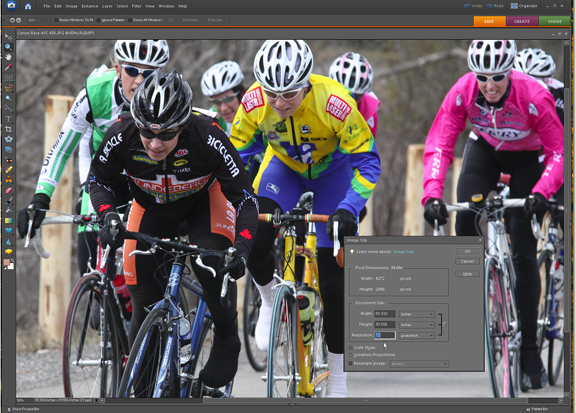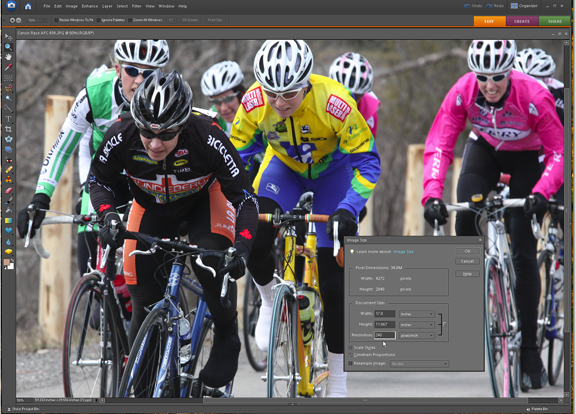Question
My wife gave me a Canon EOS Digital Rebel XSi camera recently and I wonder how large a print I can order. I always use the highest JPEG size and quality when taking photos. When I open them in Adobe Elements 7, and check the size, the information shows 59 x 37 inches. Is it really possible to get a print that large with JPEGs from this camera? J.R.
Answer
Well, J.R., the simple answer is no. A 12-megapixel image simply does not have enough pixels for such a massive print if you expect good quality. When checking the size data in Adobe Elements, you will also note that the software indicates Resolution: 72 dpi. (The term dpi means dots per inch; think of it as pixels per square inch of a print.) That’s a very low level of resolution suitable only for images viewed on a computer monitor. You need a resolution of at least 200 dpi — and preferably 240 dpi — for a true “photo-quality” print.
Try this. Open the Size or Resize utility in your Adobe software. (Use this command to do so: Image > Resize > Image Size.) Make sure that there is no check mark in the Resample Image box. Now, change the resolution amount from 72 to 240 dpi. The software will then show you the new document size at 240 dots per inch: roughly 17.8 x 11.87 inches. Assuming that your JPEG image photo is very sharp you should be able to get an excellent print of this size. (Set the resolution to 200 dpi and the size will increase to roughly 21×14-inches; print quality may still be acceptable at that size.)
Of course, the larger the print the lower the quality will be; after all, the number of pixels per square inch gets smaller as print size gets larger. Even so, you can probably get an even larger print of good quality-perhaps up to 13 x 19 inches– from your technically excellent JPEGs. There are methods for adding pixels (called interpolation) that can allow for making much larger prints.
However, for the very best results, remain conservative as to the size of prints you order. If you want only a poster, many stores will make one for you in dimensions up to 20 x 30 inches at relatively low prices. But don’t expect true photographic quality given the extra large size and the lower quality of the paper that’s used for posters.
While the data may be difficult to see in the small reproductions here, changing the resolution to 240 dpi from the default of 72 dpi (typical with many cameras) causes Adobe Elements to change the document size. The width and height dimensions that you see now provide an indication as to the largest print that you might want to order to be certain of maximum quality.


Jane
13 Jun 2009large shots are usually watched from the distance, so sometimes bad quality not a problem
Edwaste
29 Jun 2009A lot depends on the distance the print will be viewed from.
I have made many posters for trade shows where the image(s) used are 75 pixels per inch. The results were fine for that purpose, and the paper was not of a lower quality.
If you expect the viewer to look at your 59×37″ poster from the same distance as a 11 x14″ print…then I guess 72 pixels per inch is not going to work…but who is going to look at it from that distance?
You look at a photograph from a distance where the entire composition can be seen at once. Not scrutinized inch by inch, like some…. pixel peeper.
Sloah
8 Jul 2009I recently held a photography exhibition, in which I had several photos printed at A2 (16.5 x 23.4 in) from my D300 (12.3mp). I had them uprezzed using Genuine Fractals, and they came out very well. However, I wouldn’t have wanted to push the files much beyond what that – I know that it would have looked much better had I used a LF camera. Having said that, I think it would have been perfectly acceptable to have printed them at A1 (23.4 x 33.1 in) for the average viewer, if you were not to look at them too closely. This is, however, after using Genuine fractals…
PeterKBurian
11 Jul 2009Well, yes, the further a person is from a print when viewing it, the less concern re: maximum image quality and resolution.
AND the better the camera (like the D300, which is fabulous) and the sharper the photo (without blurring from camera shake (and the better the lens you use) …. the larger the print you can make of fine quality,.
But not 59×37 inches unless people would view them from a hundred feet away … maybe. 72 pixels per inch is simply not enough for good resolution. Not based on my definition of good.
Peter